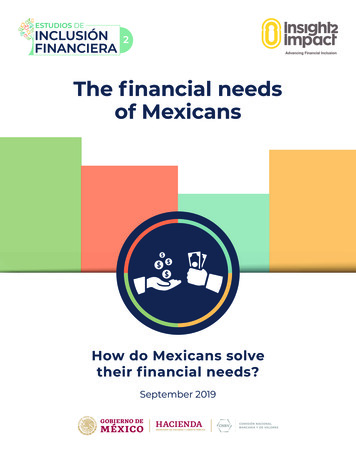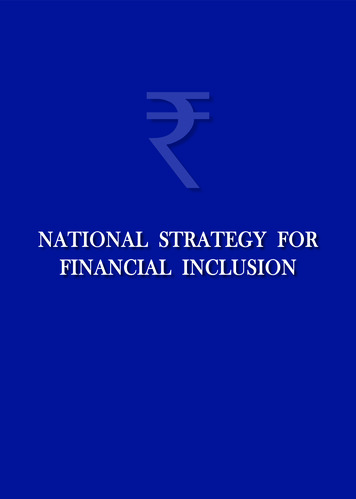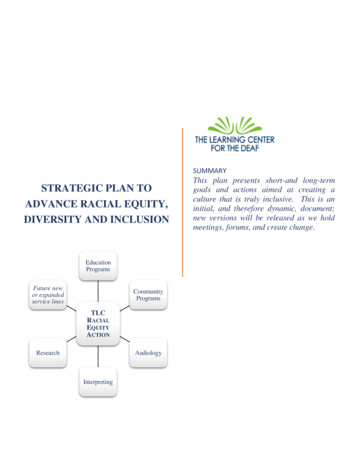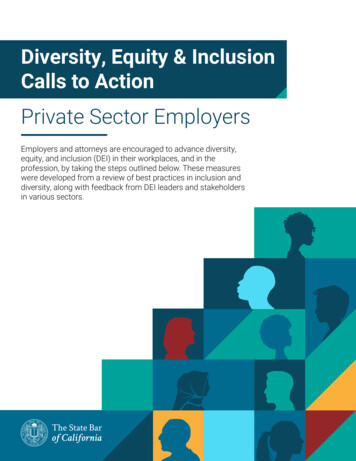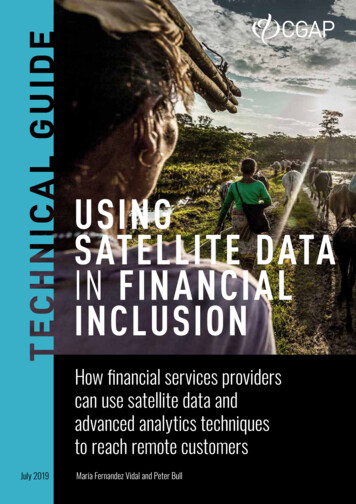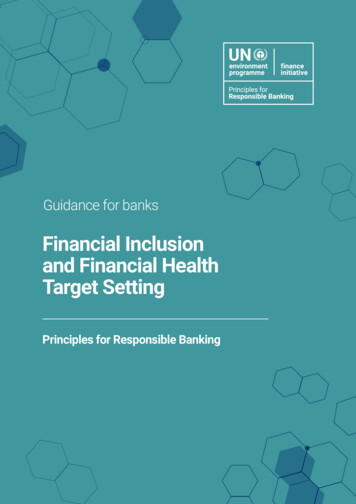
Transcription
Guidance for banksFinancial Inclusionand Financial HealthTarget SettingPrinciples for Responsible Banking
AcknowledgmentsThe content of this document is based on discussions and work undertaken in thePrinciples for Responsible Banking Target Setting for Financial Inclusion and FinancialHealth working group.
We also wish to acknowledge contributions made by the following external stakeholders:International Finance Corporation, Office of United Nations Secretary-General’s Special Advocate for Inclusive Finance for Development (UNSGSA), European Banking Federation, Alliancefor Financial Inclusion (AFI) and UNI Global Union.Project TeamMaria Eugenia Sosa TabordaLaxmi Aeshwarya KumarJohanna DichtlPuleng Ndjwili-PotelePublished by UNEP Finance Initiativein April 2021Copyright UNEP Finance InitiativeLeigh SmythGlobal Social Inclusion ConsultantUNEP Finance InitiativeInternational Environment House11–13 Chemin des AnémonesCH-1219 Châtelaine, GenevaSwitzerland
Table of contentsIntroduction5Framework for financial inclusion and financial health7Operational process for setting targets9Step 1: Understand your bank’s countrycontext and national policiesStep 2: Set baselines and identify prioritiesStep 3: Set SMART targetsStep 4: Determine measures and actionsStep 5: Define Key Performance IndicatorsExamples of targets15Appendix25Appendix A: World Bank database to understandyour country context.Appendix B: Other resources to understand your country context.Appendix C: Potential KPIs to set baselines and targets.Appendix D: Vulnerability and equalityAppendix E: Examples of financial inclusion andfinancial health initiativesPrinciples for Responsible Banking. Guidance on financial inclusion and financial health target settingTable of contents4
IntroductionFinancial inclusion and financial health are cornerstones for international development.An inclusive and healthy financial system benefits all participants—individuals havegreater and more flexible access to vital financial services; entrepreneurship is encouraged; banks are enabled to diversify their customer base and their portfolios of services/products, enhance their corporate brand, reputation and NPS (Net Promoter Score). Acountry with strong financial inclusion and financial health also has positive impacts forgovernments and the wider economy. Good financial health enables quality of life, withpeople and communities able to comfortably meet daily costs without concern, manageunexpected financial shocks and be prepared for the future. Good financial inclusion andfinancial health encourages financial planning, enabling an increased sense of securityand control.Without intervention, financial exclusion and a lack of robust financial health limitindividuals’ access to economic opportunities, create and perpetuate inequalities,increase individual exposure to significant risks and economic insecurity. Adults maybe “unbanked” or “underbanked” for reasons including unaffordability, inaccessibility, lackof awareness of financial services, low quality, financial illiteracy or incapability, or underlying economic and social inequalities that reduce their income and wealth. As well asadequate access to and usage of financial services and products, individuals and entrepreneurs need the awareness, skills, and motivation to utilize their financial resourcesin the most efficient way in present times and in the future. Inequalities have becomeeven more evident during the Covid-19 pandemic which has disproportionately impactedpeople who are vulnerable and belong to certain groups with protected characteristics.Banks with ambitious targets for financial inclusionand/or financial health can drive positive outcomesfor individuals, entrepreneurs, the whole society andthe wider economy.Principles for Responsible Banking. Guidance on financial inclusion and financial health target settingIntroduction5
This guidance supports signatory banks in their efforts to set targets for financial inclusion and financial health, in line with the requirements of the Principles for ResponsibleBanking (for further information please refer to www.unepfi.org/banking/bankingprinciples). By taking a systemic approach to financial inclusion and health and by working withpartners and stakeholders to achieve these targets, banks can lead and enable significant positive impacts for millions of people across the world.Using this guide, banks can understand how to align their core business with theSustainable Development Goals (SDGs), including SDG 1 (No Poverty), SDG 5 (GenderEquality), SDG 8 (Decent Work and Economic Growth), SDG 9 (Industry, Innovationand Infrastructure), SDG 10 (Reduced inequalities) and SDG 17 (Partnerships forthe Goals). This guidance outlines the key steps for setting targets to drive increasingeconomic and social inclusion, followed by two illustrative examples of targets in financial inclusion and financial health.This guidance was developed jointly by a working group of banking signatories of the Principles for Responsible Banking, the United Nations Environmental Programme – FinanceInitiative (UNEP FI) Secretariat, with support from Leigh Smyth, a global consultant insocial and digital inclusion.Banks can create shared value for their differentstakeholders by developing products and services,expanding their customer base, addressingindividuals’ needs more specifically and improvingtheir business models.Principles for Responsible Banking. Guidance on financial inclusion and financial health target settingIntroduction6
Framework forfinancial inclusionand financial healthIn consideration of various definitions, the working group defined financial inclusion asfollows. Financial inclusion is about democratizing financial services and “leavingno-one behind.” This means all individuals, micro and small enterprises should havethe option to access banking products and services (accounts, transactions, payments,savings, credit, digital services and insurance) via different and accessible channels(ATMs, internet banking, branches, desktop and mobile devices), which are affordableand effective (designed for all users, and actively and consistently used). Financial products and services should be designed and offered in a responsible manner by financialinstitutions.Financial health is broader than financial inclusion. Financial health (or well-being) is astate in which a person or organization can smoothly manage their current financialobligations and have confidence in their financial future.1 This includes four elements: Day-to-day – smooth short-term finances to meet short term needsResilience – absorb financial shocksGoals – reach future goalsConfidence – feel secure and in control of financesThe Framework (Figure 1) has been designed to ensure that all banks, regardless ofgeography, can consider and understand the opportunities to drive improved financialinclusion and financial health. It is crucial to understand the key components and theareas of potential focus that can enable improved outcomes to democratize financialservices for individuals, entrepreneurs, and organizations, especially those who areconsidered vulnerable and/or with protected characteristics (refer to Appendix D forvulnerability and equality).1Definition provided by UNSGSA – United Nations Secretary-General’s Special Advocate for inclusive financeand for development – that recently launched a Financial Health working group with leaders from financial anddevelopment sectorsPrinciples for Responsible Banking. Guidance on financial inclusion and financial health target settingFramework for financial inclusion and financial health7
Financial health or financial well-beingFinancial inclusion Bank account accessDigital inclusionMutli-channel accessEffective access Day-to-day financesFinancial resilienceFuture goalsConfidence, security and controlof financesFinancial education and digital skillsFocusing on vulnerability and equalityEnablers and inhibitorsProducts andservices:Internalprocesses:New or improvedproducts andservicesIncentives, nudges,credit/risk Policies,colleague training& cultureUser centeredaccessible andinclusive designData analytics:Partnerships:Improvingmeasurements,risk models andbehavior anticipationCollaboration withNGO’s, governments or otherenterprises forsystemic changesFigure 1: Framework for financial inclusion and financial healthTo set and deliver on targets for financial inclusion and financial health, banks need torecognize, and influence, the wider eco-system of regulations, products, services, andculture in which the bank operates to reflect the world and work holistically for theircustomers and communities. It is important to understand the enablers that drive positive impact and the inhibitors to be addressed to avoid or reduce any (potential) negative impacts. By engaging with partners and stakeholders, evaluating data, identifyingexisting initiatives and potential gaps, the bank can understand the role it can play andaccordingly identify its priorities.Principles for Responsible Banking. Guidance on financial inclusion and financial health target settingFramework forfinancial inclusionand financial health8
Operational processfor setting targetsThis section suggests an operational process for setting targets. Banks should be guidedby Principles for Responsible Banking requirements (detailed below) and follow the fivesteps below. In this section your bank will ascertain how to put each step into practiceand how this translates into targets in two illustrative examples outlined in section 4.1Understand your bank’s country context and national policies2Set baselines and identity priorities (based on country context and the bank’sstarting point)3Set SMART targets4Determine measures and actions5Define key performance indicatorsRequirements of the Principles for ResponsibleBanking for Setting targetsIn accordance with the Principles for Responsible Banking requirements for targetsetting, your bank’s targets should: Be Specific, Measurable, Achievable, Relevant and Time-bound (SMART). Address an area of most significant impact resulting from your bank’s activities andprovision of products and services, as identified through your bank’s impact analysis. Link to and drive alignment with, and greater contribution to, appropriate SustainableDevelopment Goals, the goals of the Paris Climate Agreement, and other relevantinternational, national or regional frameworks, as such as national public policies. Be set against a baseline, which is developed by your bank and assessed against aparticular year. Include the identification, acknowledgment of significant (potential) negative impactsof the set targets on other dimensions of the SDG/climate change/society’s goals,and steps to mitigate these should be taken as far as feasible to maximize the netpositive impact of the target. Include defined actions and milestones to meet the target.Principles for Responsible Banking. Guidance on financial inclusion and financial health target settingOperational process for setting targets9
Include definitions of key performance indicators (KPIs) to measure and monitorprogress against the targets (any changes in these definitions, and any rebasing ofbaselines should be transparent).Step 1:Understand your bank’s country contextand national policiesYour bank should first identify which national, regional and/or intra-national policy goalsand targets are relevant for the purpose of setting financial access and financial healthtargets. Country goals may be found in National Development Plans, National FinancialInclusion Strategies (where applicable for your country), or other policy documents.2Resources from the World Bank and Central Bank databases can help your bank determine national priorities. For example, the World Bank Global Findex Database 2017provides data about financial inclusion utilising nationally representative surveys, whichcan help your bank understand its country context.3The Maya Declaration could be a source for banks to identify their country policies andcommitments on financial inclusion. There are more than 70 countries with targetstowards achieving their nations’ financial inclusion agenda.4Financial health and wellbeing strategies can also be found at a countrywide level. Oneexample is the UK Financial Wellbeing strategy. It recognizes that poor financial wellbeingaffects millions of people in the UK, having negative consequences for social inclusionand the wider economy. The strategy was developed as a ten-year framework to helpachieve the vision of everyone making the most of their money and pensions. In collaboration with stakeholders across the UK, the Financial Wellbeing strategy set targets,for example: 2 million fewer people using credit for food and bills; 5 million more peopleunderstanding enough to plan for the future.5The state of financial inclusion and financial healthThe last decade has seen some improvements. The Global Findex Database(World Bank) reports a global average of 69% of adults with bank accounts in2017, compared to 51% in 2011.2345Note that the UNEP FI Portfolio Impact Analysis Tools has an in-built Country needs spx?source being-2020-2030-Money-and-Pensions-Service.pdf .Principles for Responsible Banking. Guidance on financial inclusion and financial health target settingOperational processfor setting targets10
To gain a high-level understanding of financial inclusion and financial health froma global perspective, the working group analyzed a select set of indicators fromthe Global Findex Database (World Bank) in the countries their banks operate in.Data from 18 countries6 was analyzed and demonstrated that access to bankaccounts differs widely among the analyzed countries. For example, more than99% of individuals in countries like Norway, Canada and New Zealand have bankaccounts as opposed to other countries like Ghana, the Dominican Republic andColombia with less than 50% of individuals having access to bank accounts, andwhere less than 15% percent of the population is saving for old age. When welook at financial resilience, 54% of adults can cover expenses in case of unexpected emergencies; however, this varies significantly by country.Furthermore, the data suggests differences linked to gender, economic status/wealth, location and education. Women, the lower-income population, peopleliving in rural areas as well as people with only primary education tend to be moreexcluded from accessing financial products and services and tend to be in a lessstable financial situation overall. This is also applicable for countries with betteraccess to banking services, and thus, highlights the importance of having targetsparticularly for vulnerable people and those with protected characteristics.More information can be obtained from Appendix A which includes a list of country levelindicators, split in different categories, and sources to obtain data for the countries yourbank operates in. In Appendix B, you can find additional resources available to understandyour bank’s country context and national policies.Step 2:Set baselines and identify priorities(based on country context and the bank’sstarting point)After understanding your country context, the next step would be to reflect this againstyour bank’s internal transactional data and specific surveys (where available) to set baselines and identify priorities.7Establishing baselines is critical to determine the starting point against which your bankcan set its target, to identify priorities, and to monitor progress along the years. Baselineswill also help tailor the bank’s long-term strategy to increase positive, and decrease negative, impacts.67Norway, Spain, Canada, France, New Zealand, Brazil, Russia, Turkey, Ecuador, Dominican Republic, South Africa,Ghana, Kenya, Ireland, Colombia, United Kingdom, Costa Rica and ThailandNote that the KPI list is integrated directly in the UNEP FI Portfolio Impact Analysis Tools to support the processof prioritisationPrinciples for Responsible Banking. Guidance on financial inclusion and financial health target settingOperational processfor setting targets11
Your bank should understand what quantifiable metrics are already available, what thecritical metrics are that will be required to measure from the starting point, which datayour bank should therefore start to collect in case not all relevant data is available at thispoint, and accordingly establish baselines against a specific year.It is possible and encouraged to utilize representative transactional data or to run specificsurveys to set baselines, which can also enable your bank to understand gaps, clientneeds or your current performance in relation to national priorities. Potential indicatorsfor establishing baselines can be found in Appendix C.Banks should also disaggregate data for vulnerable groups. For example: financialservices for individuals living in rural areas/specific geographic regions; loans by gender,ethnicity and low level of education; over-indebted clients or; individuals with low levelsof financial health (for further details refer to Appendix D). Your bank may find it difficultto disaggregate data for some specific vulnerable groups because of data gaps, in whichcase setting a baseline can be complemented by other local data, research from otherproviders as well as partner surveys. As your bank’s data management system improvesover time with regard to disaggregated data by vulnerable and within customer groups,your baseline can be improved accordingly.There are new evolving methodologies and approaches to measure customer’s financial health and some banks are already conducting surveys combined with transactionaldata.8 Appendix B provides some frameworks to measure financial health and AppendixE provides examples of practical application by banks.Step 3:Set SMART targetsYour bank will need to set a SMART target taking the country context and its baseline intoaccount.Targets need to be ambitious, and your bank needs to be clear about how its targetscontribute to SDGs, national goals, priorities and/or national targets. A SMART target oundIt will be vital to assess whether the achievement of the target will, or could, result in anysignificant negative impacts, and to put measures in place to monitor whether negativeimpacts do materialize. A good reference for identifying potential negative impacts oftargets is banks’ impact analysis—this may include details of impacts you should be8UNSGSA has a working group to develop financial health measurements which could be used in the future.There are some references provided by the Financial Health Network (https://finhealthnetwork.org/score/)and the Center for Financial Inclusion FINAL.2017.04.11.pdf)Principles for Responsible Banking. Guidance on financial inclusion and financial health target settingOperational processfor setting targets12
aware of, and for which your bank periodically screens. For example, your impact analysisprobably identified over-indebtedness as an impact topic associated with providing credit.Therefore your bank would acknowledge this, screen for it, and, in the event that it materializes as a significant negative impact, integrate appropriate mechanisms to mitigate it.Step 4:Determine measures and actionsThis step refers to determining measures, actions and milestones to achieve your targets.Examples of measures and actions your bank can set include:Products and services: Improve or develop new products and services targeting and designing for vulnerablecustomer groups and groups with protected characteristics as standard. Establish free-of-charge accounts for specific vulnerable groups. Develop digital solutions and digital apps designed in consideration of specific needse.g., disabilities. (Banks should be aware of the risk when offering standardized digitalsolutions that could lead to further exclusion. Financial institutions should find waysto improve digital access, motivation and skills. Banks should also mitigate the risk ofbias in the implementation of artificial intelligence and algorithms design.) Set up entrepreneur platforms or digital solutions to engage rural areas or underbanked groups e.g., women and microentrepreneurs. Develop financial and/or digital skills education programmes, financial and digital toolkits and advisory services as a preventive measure to avoid over-indebtedness and tosupport people in taking control of their financial health. Offer financial advisory services for over-indebted individuals.Improving internal processes: Improve credit and risk policies to mitigate over-indebtedness e.g., risk models toscreen early signs of over-indebtedness, behavior and income assumptions, appetiterisk by vulnerable groups. Incorporate nudges in internet banking platforms e.g., opt in/opt out options forpension funds, low-cost credit lines, warning for overdraft protection, just in timewarnings. Develop or refine financial consumer protection policies and initiatives e.g., responsiblemarketing, responsible lending, understandable language, no misleading advertisements.Principles for Responsible Banking. Guidance on financial inclusion and financial health target settingOperational processfor setting targets13
Improve remuneration strategies and policies to promote financial inclusion andfinancial health of customers e.g., incentivising long-term customer relationships andfinancial inclusion of customers that are less profitable in the short run rather thanincentivizing short-term sales targets and provisions.One enabler for achieving your targets could be to invest in staff training, cultural andinternal programs to improve financial health of employees. Employees with a healthierfinancial life may be able to design improved products and services for clients’ needs andlead to a more engaged, productive workforce.Data analytics: Improve data capture (including disaggregated data), and run data analytics to understand behaviors of different groups. Improve risk models and behavior anticipation with transactional and/or survey data. Review risk of discrimination or bias in service offerings, particularly through the useof algorithmic decision making, and mitigate identified risks through appropriate internal processes. Work and collaborate with different partners across sectors to obtain missing datae.g., utility companies, debt registers, governments, academia, NGOs.External engagement and partnerships: Collaborate with NGOs, governments, fintech’s or other enterprises and banks forinnovative initiatives and systemic changes. Set up partnerships with academia, think tanks or global networks to develop andimprove methodologies to measure financial health. Advocate for public policies for financial inclusion and financial health. Collective effort for stewardship and/or policy engagement.Your measures and actions could be designed internally and/or by taking a collaborativeapproach through engaging with partners, customers, clients and external stakeholders. Including external stakeholders could contribute to understanding the needs of yourcustomers and can lead to more innovative and more successful solutions. Collaborativeactions may ensure markets are fair and inclusive, especially for consumers in vulnerablecircumstances and those with protected characteristics.Step 5:Define Key Performance IndicatorsAfter setting targets and determining measures and actions to achieve them, your bankshould define KPIs to monitor progress towards target achievement. Banks can defineboth quantitative and qualitative indicators (refer to Appendix C for potential KPIs).Principles for Responsible Banking. Guidance on financial inclusion and financial health target settingOperational processfor setting targets14
Examples of targetsTwo examples of targets illustrate the steps of target setting: one for a financial inclusion target and another for financial health. If both impact topics apply to your bank,you could combine these targets.9Illustrative example for Financial Inclusion:Defined SMART targetBy 2025 Increase the percentage of bank accounts held by low-income customers by46% (achieving 30% of the total consumer banking accounts), and businessclients that are microentrepreneurs by 40% (achieving 20% of SMEs accounts) Raise the use of digital services (actively and consistently used) by 25% Increase loan allocation for individuals and microentrepreneurs by 20% each,disbursing USD 300 bn on loans for low-income clients and microentrepreneurs (2020–2025); and substantially decrease the level of over-indebtednessfor low-income customers and microentrepreneurs. Engage and train 10 million individuals in financial and digital educationprogrammes, in partnership with other institutions across sectors.The bank’s target aligns with SDGs 1 (No poverty), 8 (Decent work and economicgrowth) and 9 (Industry, innovation and infrastructure) and the country’s NationalFinancial Inclusion Strategy (if applicable).This target is aligned with the goals in our National Financial Inclusion Strategy whichaims to increase access to bank accounts and responsible credit for low-income population and microenterprises by 2025. The target aims to increase economic participationin our economy, thereby reducing poverty and ensuring that men and women, in particular those in the low-income segment, have equal access to economic resources throughfinancial services and mobile solutions, as envisaged by SDG target 1.4. It also drivesalignment with SDG targets 8.3, 8.10 and 9.3 by increasing access to affordable bankaccounts and responsible credit for micro-enterprises, therefore supporting their growth.9Please note that there are overlaps with the impact area Gender Equality, in case your bank has identifiedwomen as a vulnerable customer group to focus on and set financial inclusion and health targets for. In thiscase you can get more information in the Gender Equality Target Setting Guidance DocumentPrinciples for Responsible Banking. Guidance on financial inclusion and financial health target settingExamples of targets15
We particularly seek to increase the number of bank accounts held by low-incomecustomers and micro-enterprises by 40% and 30% respectively, and work towardsincreasing the proportion of loans in our retail portfolio by 20% for low-income customers and micro-enterprises each. We are responding to the challenges and needs of ourcountry of operation, taking into account the proportion of unbanked and underbankedpopulation, as well as our baseline. In addition, our target could facilitate the creationof decent work and contribute to economic growth, by supporting entrepreneurshipand encouraging the formalization and growth of enterprises.This example focused on low-income customers, but a similar rationale can be appliedfor other vulnerable groups and/or groups with protected characteristics. It is crucialthat banks also monitor significant negative impacts and unintended consequencesthat may result from its targets. It is important to take a holistic approach and understand the underlying inhibitors and enablers, in order to mitigate the potential negativeimpacts identified.Refer to Appendix E for examples on financial inclusion.Principles for Responsible Banking. Guidance on financial inclusion and financial health target settingExamples of targets16
Banking access(the bank shouldconsider the numberand percentage oflow-income populationand microentrepreneurs in the country inaccordance to nationaldefinitions)STEP 1:Understand country contextSTEP 2:Set baselines andprioritiesSTEP 3:Set SMARTTargetsSTEP 4:Determine measuresand actionsIn the country thebank operates in,there is a considerable financial inclusion gap:Internally, the bankidentified the following regarding itsclients (in 2020):The bank’sformulatedSMART Target(by 2025):The bank engaged with relevant internal andexternal stakeholders to develop a plan to reachits targets by 2025. The plan defined the following measures, actions and KPIs:40% of the country'spopulation can beconsidered low-incomeand 50% of adults donot have a bankingaccount20% of our bankingaccounts are fromlow-income customersDevelop a communications strategy, includinga digital campaign, toreach potential low-income customers andmicroentrepreneurs toinform and encouragethem to open a bankaccount.Percentage of low-income customers' banking accounts versustotal customers' bankingaccounts, increase by8% per year (includingmobile accounts, feefree accounts and virtualwallets)There are 2.5 milionsSMEs in the country ofwhich 90% are microenterprises and30% do not have abanking account15% of our businessaccounts are frommicroentrepreneursIncrease thepercentage ofbank accountsheld by low-income customersby 46% (achieving30% of the totalconsumer bankingaccounts), andbusiness clientsthat are microentrepreneurs by 40%(achieving 20% ofSMEs accounts) by2025.Launch fee-free digitalaccounts and virtualwallets.Percentage of microentrepreneur accountsversus total SMEsbanking accounts peryear, increase by 6% peryear (including mobileaccounts, fee-freeaccounts and virtualwallets)Principles for Responsible Banking. Guidance on financial inclusion and financial health target settingExamples of targetsSTEP 5:Define KPIs17
Effective accessSTEP 1:Understand country contextSTEP 2:Set baselines andprioritiesSTEP 3:Set SMARTTargetsSTEP 4:Determine measuresand actionsSTEP
and targets are relevant for the purpose of setting financial access and financial health targets. Country goals may be found in National Development Plans, National Financial Inclusion Strategies (where applicable for your country), or other policy documents.2 Resources from the World Bank and Central Bank databases can help your bank deter-
